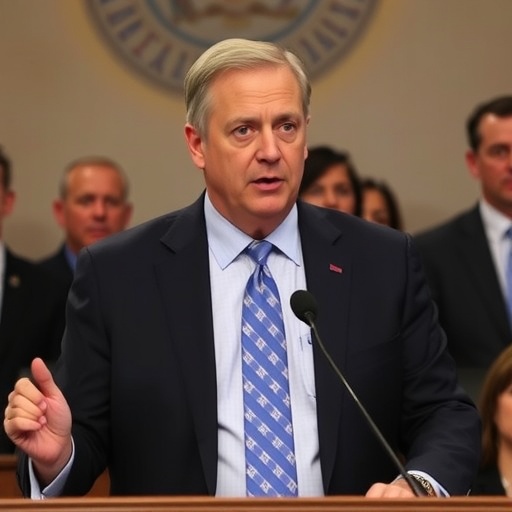Government shutdown Enters Fourth Week: Speaker Mike Johnson Foresees Record-Breaking Standoff Over Healthcare Cuts
In a stark warning that has sent ripples through Washington and beyond, House Speaker Mike Johnson predicted on Tuesday that the ongoing Government shutdown could shatter historical records, potentially eclipsing the 21-day impasse of 1995-96. As the federal budget deadlock stretches into its fourth week, essential services teeter on the brink, federal workers face unpaid wages, and bipartisan finger-pointing intensifies over healthcare negotiations. With Congress deadlocked, Johnson’s ominous forecast underscores a crisis that threatens to upend American lives and the economy at large.
The shutdown, triggered by irreconcilable differences on spending priorities, has already furloughed over 800,000 federal employees and halted operations at key agencies like the National Park Service and the Department of Homeland Security. Johnson’s comments, delivered during a tense press conference on Capitol Hill, came as polls reveal equal blame assigned to Democrats and Republicans, fueling public outrage and calls for swift resolution.
Shutdown’s Escalating Impact on Everyday Americans
The Government shutdown is no longer an abstract political skirmish; it’s a tangible hardship etching into the lives of millions. Federal employees, from air traffic controllers to Smithsonian curators, are navigating the uncertainty of delayed paychecks, with many dipping into savings or relying on food banks to make ends meet. According to the Partnership for Public Service, an estimated 2.1 million federal workers and contractors are affected, with non-essential personnel furloughed and essential staff working without compensation.
Consider the story of Maria Gonzalez, a USDA inspector in California, who shared her plight in a viral social media post: “I’ve served my country for 15 years, but now I’m choosing between groceries and rent. This Congress needs to wake up.” Her sentiment echoes across the nation, as small businesses near national parks report losses exceeding $76 million daily during previous shutdowns—a figure likely surpassed now.
Economically, the ripple effects are profound. The Congressional Budget Office (CBO) projects that each week of shutdown could shave 0.1% off GDP growth, translating to billions in lost productivity. Travel and tourism sectors, already battered, face further blows; Yosemite National Park, for instance, remains partially closed, deterring visitors and costing local economies dearly. Meanwhile, delayed FDA inspections have raised alarms about food safety, with perishable imports piling up at ports.
Health services are particularly strained. The Centers for Disease Control and Prevention (CDC) has scaled back routine operations, postponing disease outbreak responses and research grants. Veterans Affairs hospitals continue to operate, but staffing shortages loom as unpaid workers burn out. In a poignant example, cancer research funding from the National Institutes of Health (NIH) has frozen, stalling clinical trials and leaving patients in limbo. “This isn’t just politics; it’s lives on hold,” said Dr. Elena Ramirez, an NIH researcher whose grant was suspended mid-study.
Mike Johnson’s Dire Forecast: A Shutdown Longer Than History’s Worst
House Speaker Mike Johnson, a Louisiana Republican navigating his first major crisis in the role, didn’t mince words when addressing reporters. “If we don’t bridge this divide soon, we’re looking at a shutdown that could last longer than the 1995-96 record of 21 days,” Johnson stated, his voice laced with frustration. That earlier shutdown, under President Bill Clinton, cost the economy an estimated $1.4 billion and led to widespread public backlash.
Johnson’s prediction stems from the entrenched positions in Congress. Republicans, led by fiscal conservatives, demand deeper healthcare negotiations to curb what they call unsustainable entitlements spending, targeting programs like Medicaid and Affordable Care Act subsidies. Democrats counter that such cuts would devastate vulnerable populations, insisting on protections for low-income families and rural hospitals.
Behind the scenes, Johnson’s leadership is under scrutiny. Elected Speaker in October 2023 amid GOP infighting, he has struggled to unify his slim majority. Sources close to the negotiations reveal that House Republicans rejected a Senate compromise bill last week, which proposed modest budget trims without touching healthcare. “The Speaker is walking a tightrope,” one anonymous GOP aide confided. “Pushing too hard risks a revolt from the Freedom Caucus; yielding looks like weakness to the base.”
Historically, shutdowns have varied in length and severity. The 2018-19 standoff, the longest at 35 days, centered on border wall funding and ended with a bipartisan deal. Today’s impasse, however, feels uniquely polarized, exacerbated by post-pandemic fiscal strains and inflation concerns. Johnson’s forecast isn’t hyperbole; with the holiday season approaching, seasonal furloughs could amplify disruptions, pushing the duration into uncharted territory.
Healthcare Cuts Fuel the Fire in Budget Battles
At the epicenter of this government shutdown lies a fierce debate over healthcare negotiations, where visions for the federal budget collide. Republicans advocate for $2 trillion in savings over the next decade, including reforms to Medicare reimbursement rates and block grants for Medicaid that could reduce federal contributions by 20%. Proponents argue this addresses the program’s projected $50 trillion shortfall by 2050, per CBO estimates.
Democrats, however, view these proposals as a direct assault on the safety net. Senate Majority Leader Chuck Schumer lambasted the GOP plan as “cruel and shortsighted,” warning it would strip coverage from 15 million Americans. A key sticking point is the expansion of Medicaid under the ACA, which covers 40% of U.S. births and serves 7 in 10 children in poverty. Cutting it, Democrats say, would spike uninsured rates and hospital bankruptcies, especially in red states that initially resisted but later embraced the expansion.
Expert analysis underscores the stakes. The Kaiser Family Foundation reports that healthcare spending accounts for 28% of the federal budget, or about $1.5 trillion annually. Trimming it without bipartisan buy-in risks legal challenges and state-level rebellions. “This isn’t just about numbers; it’s about access,” noted health policy analyst Dr. Raj Patel in a recent op-ed. “Rural clinics are already closing at alarming rates—shutdown cuts would accelerate that crisis.”
Negotiations have seen glimmers of progress, only to falter. A working group proposed tying healthcare reforms to infrastructure investments, but ideological purists on both sides balked. House Minority Leader Hakeem Jeffries accused Mike Johnson of “grandstanding” to appease donors, while Johnson retorted that Democrats are “obstructing common-sense fiscal responsibility.” As talks drag on, the impasse exposes deeper rifts in Congress, where short-term funding bills have become the norm since 2010, fostering a cycle of brinkmanship.
Public Polls Pin Equal Blame on Partisan Gridlock
As the government shutdown grinds on, public sentiment has crystallized into widespread frustration, with polls indicting both parties equally. A Quinnipiac University survey released Monday found 48% of voters blame Republicans and 47% fault Democrats for the stalemate—a rare bipartisan indictment in a polarized era. Only 5% expressed approval of Congress‘ handling, the lowest since the 2018 shutdown.
This even split reflects the nuanced fault lines. Among independents, disapproval of Mike Johnson stands at 55%, per the poll, citing his inability to corral GOP hardliners. Yet Democrats fare no better, with 52% of respondents criticizing their refusal to negotiate on entitlement reforms. Urban voters, hit hardest by service disruptions, lean toward blaming Republicans, while rural constituencies echo GOP talking points on budget bloat.
The data paints a picture of voter exhaustion. Gallup tracking shows congressional approval at a dismal 18%, down from 25% pre-shutdown. Social media amplifies the discontent: #EndTheShutdown trends with over 500,000 posts, featuring stories from affected families and calls for term limits. Economists warn that prolonged uncertainty could erode consumer confidence, already shaky at 102.5 on the Conference Board index.
Advocacy groups are mobilizing. The AFL-CIO has rallied 10,000 federal workers in D.C. protests, demanding back pay guarantees. On the other side, the Heritage Foundation urges deeper cuts, publishing a report claiming the federal budget deficit—$1.7 trillion last year—necessitates immediate action. This public pressure might force compromise, but with midterm elections looming in 2026, politicians may prioritize posturing over progress.
Pathways Forward: Breaking the Budget Impasse Before It’s Too Late
Looking ahead, resolving this government shutdown hinges on creative healthcare negotiations and political will in Congress. Speaker Mike Johnson has hinted at a possible vote on a short-term funding extension by week’s end, buying time for substantive talks. Bipartisan senators, including moderates like Susan Collins and Joe Manchin, are drafting a “grand bargain” that pairs modest healthcare trims with tax incentives for small businesses and increased border security funding.
Yet challenges abound. The debt ceiling, set to be breached in early 2025, looms as a concurrent crisis, potentially compounding the shutdown’s fallout. If unresolved, analysts predict a credit downgrade like 2011’s, raising borrowing costs by $100 billion annually. International observers, from the IMF to EU leaders, express concern over U.S. instability rippling globally, with stock markets dipping 2% since the shutdown began.
Optimists point to historical precedents: the 1995 shutdown ended with welfare reform compromises, paving the way for balanced budgets. Today, a similar deal could emerge if Johnson leverages his gavel to sideline extremists. President Biden, in a White House address, urged unity: “This shutdown hurts real people—let’s get back to governing.” As Thanksgiving approaches, the pressure mounts for lawmakers to prioritize constituents over ideology.
Ultimately, the trajectory depends on whether Congress can transcend partisanship. With Johnson’s record-breaking warning echoing, the nation braces for either breakthrough or deeper turmoil, underscoring the fragility of democratic governance in divided times.









